SL Navy in North: A strength to islanders
October 28, 2021By Dishan Joseph
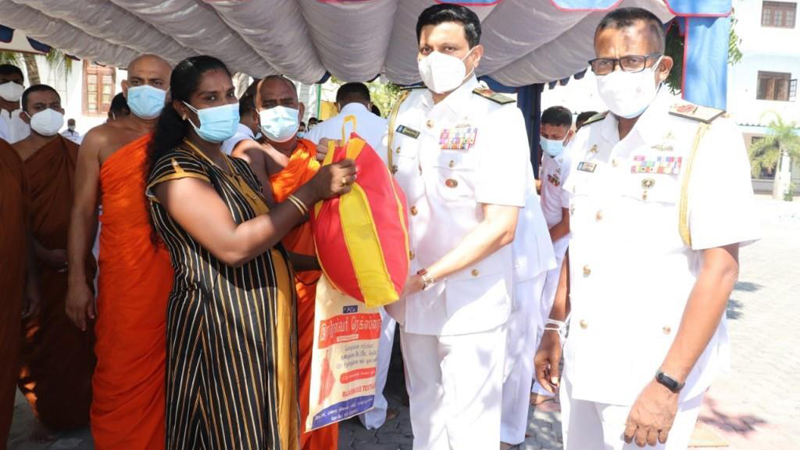
Navy Commander makes a donation at Nainatheevu
The Northern Province of Sri Lanka has many islands. These islands have been inhabited for decades. Often the visitors from outside of Jaffna are not even aware of these islands. On a recent visit to Jaffna, I was able to visit some of these islands with the help of the Northern Naval Command located at Kankesanthurai.
On a sunny Saturday morning, we set off from Jaffna, travelling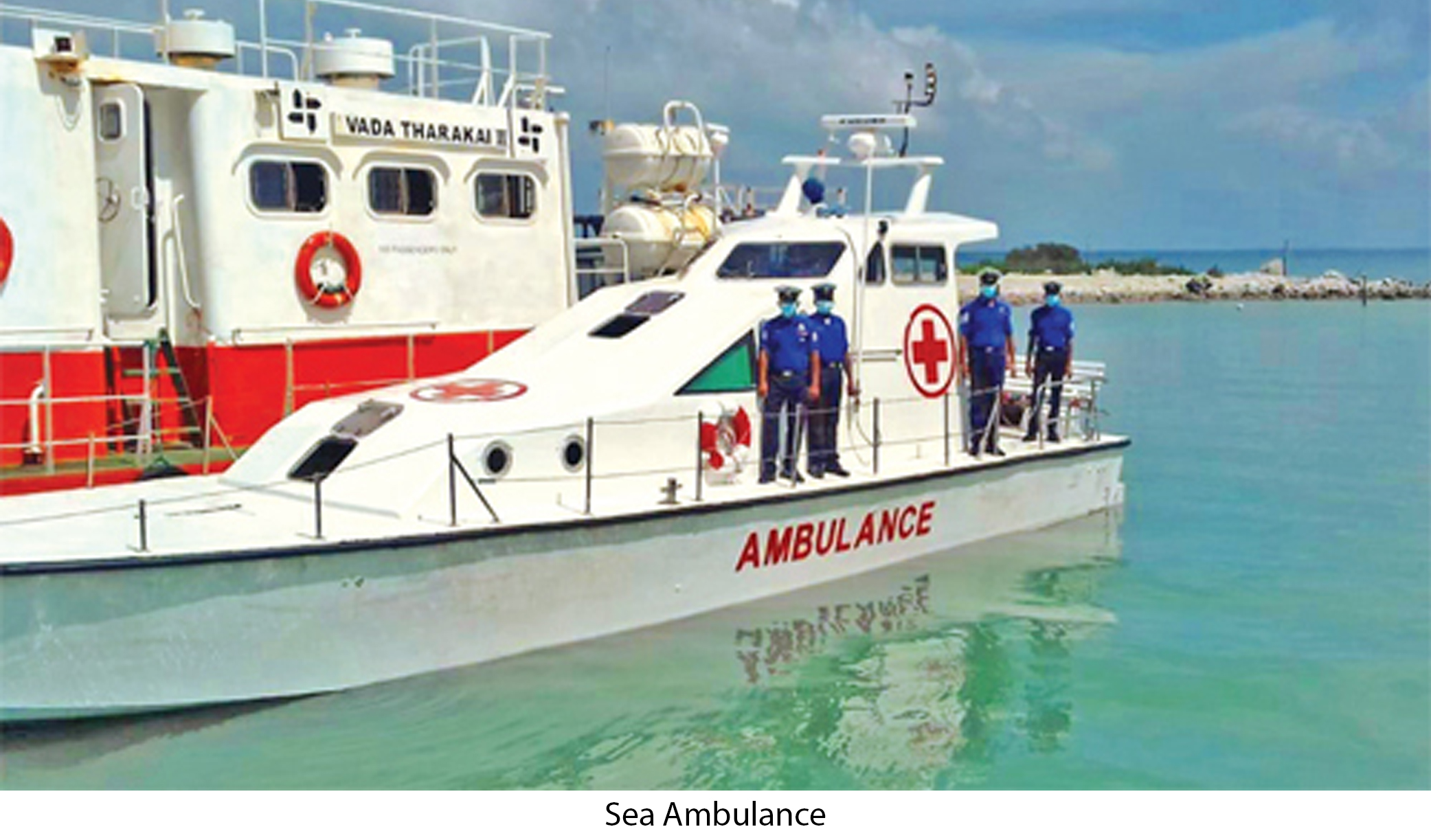 by jeep to the Navy pier at Kuriyakkadduvan, known among the sailors as KKD. We passed Mandaithivu and Punguduthivu. I observed vast expanses of land dotted with palmyrah trees. As we neared, the pier boats belonging to local fishermen were visible. A naval crew was already waiting in their Inshore Patrol Craft (IPC) commonly known as water jet.
by jeep to the Navy pier at Kuriyakkadduvan, known among the sailors as KKD. We passed Mandaithivu and Punguduthivu. I observed vast expanses of land dotted with palmyrah trees. As we neared, the pier boats belonging to local fishermen were visible. A naval crew was already waiting in their Inshore Patrol Craft (IPC) commonly known as water jet.
After wearing my life jacket and taking a position on the boat, its engines sputtered to life and we began our journey towards Delft Island. The water foamed as the IPC cut through waves. As we neared the naval pier, I could make out the name board of the naval station - SLNS Wasaba. The boat was moored and we proceeded towards an office. The Commanding Officer in charge of Delft Island, Commander H.A.C. Fernando greeted me and we sat down to talk about the role of the Navy in assisting the people of this historic island.
The naval station was initially set up here in 2002 and enhanced during 2007. The Navy maintains the security of the island. Their patrols act as a powerful deterrent to smugglers. Delft Island also has a small police station and a post office. This island has a population of about 4,500 people. One of the important services provided free of charge by the Sri Lanka Navy is the passenger ferry service. They operate a modern ferry which can safely move 100 persons.
The vessel Vadatharakai makes many trips on a daily basis. The first begins at 6 am from Delft to Kuriyakkadduvan (KKD) pier. Then at 7.30 am, she comes back to Delft Island. This journey moves the office workers who travel from here to places like Jaffna. Once again, the ferry sails at 10 am from Delft Island to KKD pier. On this journey, people who have errands in other towns travel from here. At 2 pm the ferry comes back to Delft Island. The Vadatharakai ferry makes her final trip for the day at 5.30 pm bringing back the workers to the island. This essential sea transport connects the civilians of Delft Island and enables them to work and live with dignity. The others on the island engage in fishing activity. Life on an island has its own challenges from rough seas to medical emergencies. Once again, the Navy operates a fully equipped Sea Ambulance. This modified boat sails with a red cross. It has transported many patients by day and night and duly saved hundreds of lives.
 The Navy Sea Ambulance is on standby 24 hours a day. Critical patients from the island are rushed to the pier at Kayts Island from where a land transport takes them to the main hospital at Jaffna town or to a suitable hospital depending on the medical situation. The Sea Ambulance provided free of charge is an endorsement of the goodwill that exists between the civilians and the Sri Lanka Navy. The people on the island are provided one tonne of drinking water daily by the good efforts of the Navy who uses a reverse osmosis plant to purify the seawater. This service is also provided free to the people of this island.
The Navy Sea Ambulance is on standby 24 hours a day. Critical patients from the island are rushed to the pier at Kayts Island from where a land transport takes them to the main hospital at Jaffna town or to a suitable hospital depending on the medical situation. The Sea Ambulance provided free of charge is an endorsement of the goodwill that exists between the civilians and the Sri Lanka Navy. The people on the island are provided one tonne of drinking water daily by the good efforts of the Navy who uses a reverse osmosis plant to purify the seawater. This service is also provided free to the people of this island.
Fishermen who go out to sea can become lost and when a mayday alarm is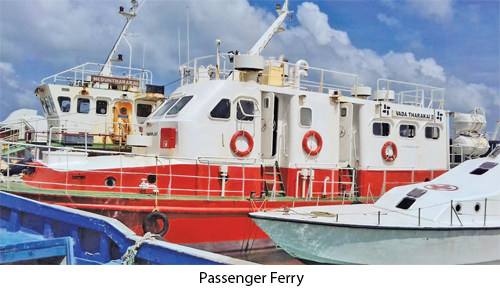 raised, naval craft go into rescue mode and have saved many stranded fishermen over the years. The Catholic community of both Sri Lanka and India take part in the annual church feast at Katchatheevu Island. During this time, the security for the thousands of visitors to Katchatheevu Island is coordinated from Delft Island. All sea transport of Catholic clergymen to Katchatheevu Island takes place from the naval station on Delft Island. This is how the islands are united. The other surrounding islands are Karaitheevu, Elluwatheevu, Analaitheevu, Nainatheevu and Pungudutheevu.
raised, naval craft go into rescue mode and have saved many stranded fishermen over the years. The Catholic community of both Sri Lanka and India take part in the annual church feast at Katchatheevu Island. During this time, the security for the thousands of visitors to Katchatheevu Island is coordinated from Delft Island. All sea transport of Catholic clergymen to Katchatheevu Island takes place from the naval station on Delft Island. This is how the islands are united. The other surrounding islands are Karaitheevu, Elluwatheevu, Analaitheevu, Nainatheevu and Pungudutheevu.
Delft Island has many historic monuments. Among these is the old fort whose remains can be seen today. The island is also home to the massive Baobab tree which had been planted here centuries ago. Herds of wild horses peacefully roam around here and are believed to be the offspring of horses once brought here during the Portuguese occupation. The Navy operates a sewing centre employing 36 civilians. These women have a full-time job there and live with dignity. I visited the sewing centre and observed the staff at work.
 After having some tea, we boarded the water jet and cruised towards the Island of Nainatheevu (also known as Nagadeepa). As the boat came closer to the pier, we could make out the gopuram (tower) of the Nagapooshani Amman Kovil. This kovil has attracted devotees for centuries. The boat was moored and we walked towards the entrance of the Nagadeepa Buddhist Temple. On this island, the Navy has a small detachment commanded by Lieutenant Commander Kumara. The Navy assists the Nagadeepa Temple in many ways.
After having some tea, we boarded the water jet and cruised towards the Island of Nainatheevu (also known as Nagadeepa). As the boat came closer to the pier, we could make out the gopuram (tower) of the Nagapooshani Amman Kovil. This kovil has attracted devotees for centuries. The boat was moored and we walked towards the entrance of the Nagadeepa Buddhist Temple. On this island, the Navy has a small detachment commanded by Lieutenant Commander Kumara. The Navy assists the Nagadeepa Temple in many ways.
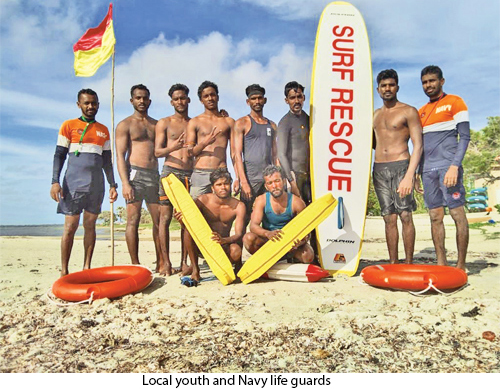
In addition, they patrol and maintain the security of the island which has a population of 3,000. The annual feast of the Nagapooshani Amman Kovil also receives the Navy’s assistance. On Nainatheevu Island, the Navy has a craft on standby for any medical emergency to rush patients to the KKD pier and a forward land hospital. Every year, the Navy transports exam papers for the students sitting the GCE Ordinary Level exams and the Grade 5 scholarship exams. During any election, the polling cards are sea transported on Navy boats including the officials manning the polling booth.
The Navy has engaged its manpower in refurbishing some wards at the government hospital on Nainatheevu Island. Another key project is the planting of mangroves. Working with the Wildlife Department, naval personnel have restored many mangroves thereby sustaining the sensitive ecosystem. During the recent Covid vaccination programme, the Navy transported the vaccines and all medical staff by sea to sustain the people of this solitary island. During the curfews, food rations were shared with the civilians from the naval stores. In addition, the local youth have been selected and trained in lifesaving methods by Navy personnel.
The Navy has launched another social responsibility initiative, under the directives and guidance of Navy Commander, Vice Admiral Nishantha Ulugetenne and the Northern Naval area Commander, Rear Admiral U.V.M. Perera, by introducing water sports to the Jaffna community plus, the first-ever surf bronze medallion course to community volunteers in Jaffna. Sri Lanka Life Saving (SLLS) Association and North Wind Project facilitated the programme. Its main objective is to create a group of people with the knowledge, attitude and skills to deal with water-related lifesaving activities and train the trainers in the Northern Province and subsequently to pass on these skills to Jaffna school children creating an interest in water sports.
This is a good way for youth to bond and live together. I realised on these remote islands the civilians appreciate the support of the Navy. There is a genuine spirit of trust and goodwill. After a late lunch, we boarded the craft and sailed back to the KKD pier. My visit to these islands was very interesting and made me realise the role and task of the Sri Lanka Navy in empowering the lives of the people here. The sun gently receded as our jeep headed back to Jaffna town.
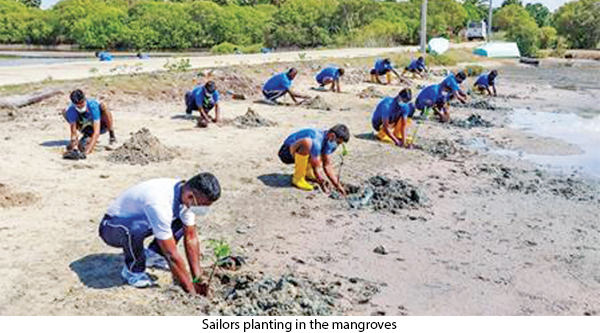

(The writer wishes to express his sincere thanks to the Navy Commander and the Officers of Northern Naval Command)
Courtesy - www.dailynews.lk